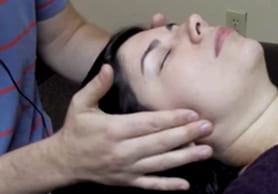 One of the most fascinating and challenging pieces of anatomy is the understanding of the temporo-mandibular joint (TMJ), its function and its dysfunction.
One of the most fascinating and challenging pieces of anatomy is the understanding of the temporo-mandibular joint (TMJ), its function and its dysfunction.
The TMJ joint is the most used joint in the body. It has – like the knee – an articular disc within it! If this disc gets displaced or injured, just like a meniscus in the knee, then you’ve got dysfunction. The good news is it is not usually severe and often self-correcting!
Normally when we open our mouths just a little, the round process on the back of the mandible, the jaw bone, presses up against the disc in the TMJ. When we open our mouths even wider the mandible and the disc above it actually slide forward allowing for the bigger opening. Then, as we close, the mandible and the disc both slide back – this forward and back movement of the disc and mandible is called “translation.”
 Now sometimes, through prolonged or acute opening of the jaw or injury, the disc can slide forward of the articulating process of the mandible. This can be painful and make one certainly not want to open the jaw so wide. Over time, the disc can recede back. However, when it’s displaced, as the mandible comes forward and back, it can make a very distinct clicking sound which is the mandible’s riding under and then again behind the disc.
Now sometimes, through prolonged or acute opening of the jaw or injury, the disc can slide forward of the articulating process of the mandible. This can be painful and make one certainly not want to open the jaw so wide. Over time, the disc can recede back. However, when it’s displaced, as the mandible comes forward and back, it can make a very distinct clicking sound which is the mandible’s riding under and then again behind the disc.
Fortunately the tissue behind the disc over time often becomes more disc-like and this resolves the problem brilliantly on its own. However, sometimes soft tissue work can result in the disc slipping back into its correct position more easily and earlier. Also massage of course helps relax the jaw, relieve pain, and the tension that pain brings.
As a matter of fact, the jaw is really a kind litmus-test area for stress. So many people suffer from grinding the jaw or keeping it tense due to excess stress and stimulation of the fight or flight response. Massage, which can stimulate the opposite response – the rest and repose response – is one of the most effective ways to relieve this fight or flight syndrome (we call it “hypersympathenonia”).
So massage can not only help treat the dysfunction in the joint and muscles – it can have a dramatic effect on the causes of jaw pain which often involve the stress response of the nervous system!
Learn more at the Clinical Massage for TMJ Dysfunction workshop with Christopher Fritel on September 12-13. CLICK HERE to register today!

